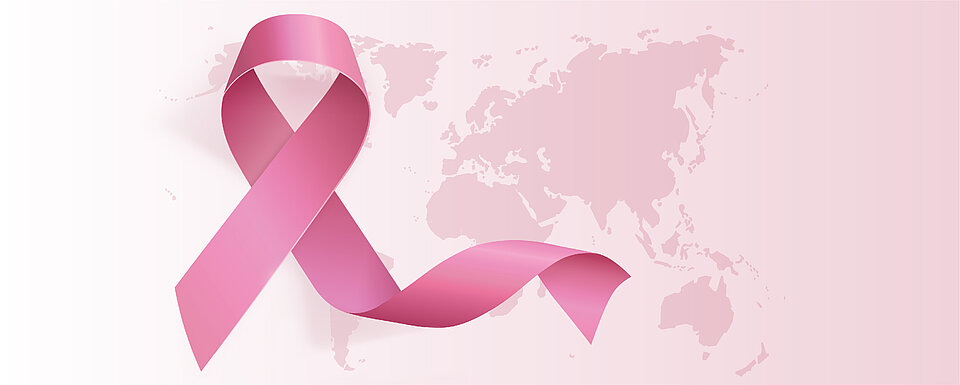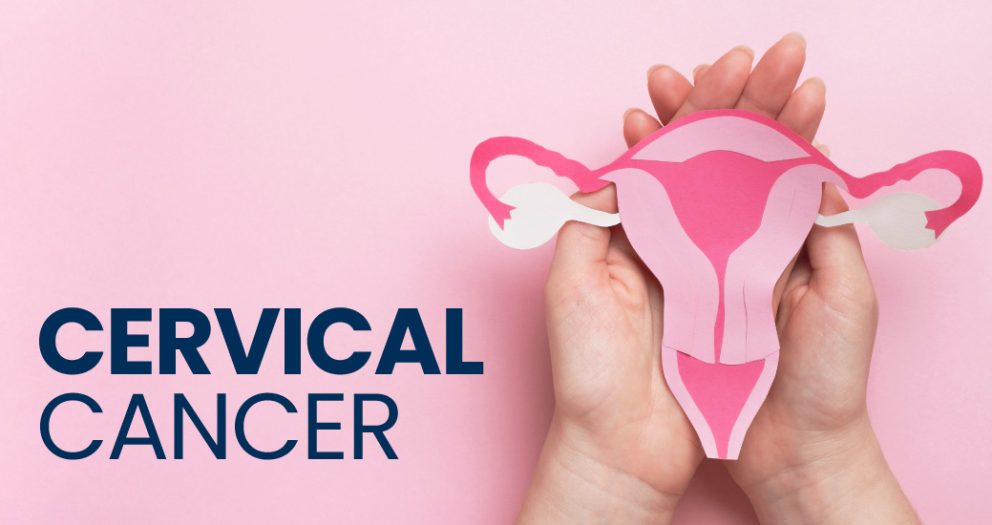What is breast cancer?
Breast cancer originates in your breast tissue. It occurs when breast cells mutate (change) and grow out of control, creating a mass of tissue (tumor). Like other cancers, breast cancer can invade and grow into the tissue surrounding your breast. It can also travel to other parts of your body and form new tumors. When this happens, it’s called metastasis. (1)
Symptoms (2)
Signs and symptoms of breast cancer may include:
- A breast lump or thickening that feels different from the surrounding tissue
- Change in the size, shape, or appearance of a breast
- Changes to the skin over the breast, such as dimpling
- A newly inverted nipple
- Peeling, scaling, crusting, or flaking of the pigmented area of skin surrounding the nipple (areola) or breast skin
- Redness or pitting of the skin over your breast, like the skin of an orange
When to see a doctor
If you find a lump or other change in your breast — even if a recent mammogram was normal — make an appointment with your doctor for prompt evaluation.

Causes(3)
After puberty, a female’s breasts are made up of fat, connective tissue, and thousands of lobules. These are tiny glands that can produce milk. Tiny tubes, or ducts, carry the milk toward the nipple.
Breast cancer develops as a result of genetic mutations or damage to DNA. These can be associated with exposure to estrogen, inherited genetic defects, or genes that can cause cancer, such as the BRCA1 and BRCA2 genes.
When a person is healthy, their immune system attacks any abnormal DNA or growths. When a person has cancer, this does not happen.
As a result, cells within breast tissue begin to multiply uncontrollably, and they do not die as usual. This excessive cell growth forms a tumor that deprives surrounding cells of nutrients and energy.
Breast cancer usually starts in the inner lining of the milk ducts or the lobules that supply them with milk. From there, it can spread to other parts of the body.
Factors that are associated with an increased risk of breast cancer include:(4)
- Being female. Women are much more likely than men to develop breast cancer.
- Increasing age. Your risk of breast cancer increases as you age.
- A personal history of breast conditions. If you’ve had a breast biopsy that found lobular carcinoma in situ (LCIS) or atypical hyperplasia of the breast, you have an increased risk of breast cancer.
- A personal history of breast cancer. If you’ve had breast cancer in one breast, you have an increased risk of developing cancer in the other breast.
- A family history of breast cancer. If your mother, sister, or daughter was diagnosed with breast cancer, particularly at a young age, your risk of breast cancer is increased. Still, the majority of people diagnosed with breast cancer have no family history of the disease.
- Inherited genes that increase cancer risk. Certain gene mutations that increase the risk of breast cancer can be passed from parents to children. The most well-known gene mutations are referred to as BRCA1 and BRCA2. These genes can greatly increase your risk of breast cancer and other cancers, but they don’t make cancer inevitable.
- Radiation exposure. If you received radiation treatments to your chest as a child or young adult, your risk of breast cancer is increased.
- Obesity. Being obese increases your risk of breast cancer.
- Beginning your period at a younger age. Beginning your period before age 12 increases your risk of breast cancer.
- Beginning menopause at an older age. If you began menopause at an older age, you’re more likely to develop breast cancer.
- Having your first child at an older age. Women who give birth to their first child after age 30 may have an increased risk of breast cancer.
- Having never been pregnant. Women who have never been pregnant have a greater risk of breast cancer than women who have had one or more pregnancies.
- Postmenopausal hormone therapy. Women who take hormone therapy medications that combine estrogen and progesterone to treat the signs and symptoms of menopause have an increased risk of breast cancer. The risk of breast cancer decreases when women stop taking these medications.
Drinking alcohol. Drinking alcohol increases the risk of breast cancer.
Breast Cancer Stages(5)
The stages are the number zero and the Roman numerals I, II, III, or IV (often followed by A, B, or C). In general, the higher the number, the more advanced cancer. But there’s more to it than that.
Stage 0. Cancer has been diagnosed early. It started in the breast ducts or milk glands and has stayed there. You’re likely to hear or see the words in situ, meaning “in the original place.” Get more details about stage 0 breast cancer types and treatment options.
Stage I. starting at this level, breast cancer is called invasive, meaning it has broken free to attack healthy tissue.
Stage 1A means cancer has spread into the fatty breast tissue. The tumor itself is no larger than a shelled peanut, or there may be no tumor.
Stage IB means some cancer cells, but just tiny amounts, have been found in a few lymph nodes.
Stage II. Cancer has grown, spread, or both.
IIA means the tumor in the breast is still small if there’s one at all. There may be no cancer in the lymph nodes, or it may have spread to as many as three.
A stage IIB breast tumor is bigger — it may be the size of a walnut or as big as a lime. It may or may not be in any lymph nodes.
Stage III. Cancer has not spread to bones or organs, but it’s considered advanced, and it’s harder to fight.
IIIA means cancer has been found in up to nine of the lymph nodes that form a chain from your underarm to your collarbone. Or it has spread to or enlarged the lymph nodes deep in your breast. In some cases, there is a large tumor in the breast, but other times there’s no tumor.
IIIB means the tumor has grown into the chest wall or skin around your breast, even if it hasn’t spread to the lymph nodes.
IIIC means cancer has been found in 10 or more lymph nodes or has spread above or below your collarbone. It’s also IIIC if fewer lymph nodes outside the breast are affected but those inside it are enlarged or cancerous.
Stage IV. Breast cancer cells have spread far away from the breast and lymph nodes right around it. The most common sites are the bones, lungs, liver, and brain. This stage is described as “metastatic,” meaning it has spread beyond the region of the body where it was first found.
What can I do to reduce my risk of breast cancer?
Research shows that lifestyle changes can decrease the risk of breast cancer, even in women at high risk. To lower your risk:(6)
- Limit alcohol.
- Maintain a healthy weight.
- Be physically active.
- Breast-feed. Breastfeeding might play a role in breast cancer prevention. The longer you breastfeed, the greater the protective effect.
- Limit postmenopausal hormone therapy. Combination hormone therapy may increase the risk of breast cancer. Talk with your doctor about the risks and benefits of hormone therapy. You might be able to manage your symptoms with nonhormonal therapies and medications. If you decide that the benefits of short-term hormone therapy outweigh the risks, use the lowest dose that works for you and continue to have your doctor monitor the length of time you’re taking hormones.
- Take your daily supplements like Vitamin D, Calcium, and probiotics
How Is Breast Cancer Diagnosed?(7)
Doctors often use additional tests to find or diagnose breast cancer. They may refer women to a breast specialist or a surgeon. This does not mean that she has cancer or that she needs surgery. These doctors are experts in diagnosing breast problems.
- Breast ultrasound. A machine that uses sound waves to make pictures, called sonograms, of areas inside the breast.
- Diagnostic mammogram. If you have a problem in your breast, such as lumps, or if an area of the breast looks abnormal on a screening mammogram, doctors may have you get a diagnostic mammogram. This is a more detailed X-ray of the breast.
- Breast magnetic resonance imaging (MRI). A kind of body scan that uses a magnet linked to a computer. The MRI scan will make detailed pictures of areas inside the breast.
- Biopsy. This is a test that removes tissue or fluid from the breast to be looked at under a microscope and do more testing. There are different kinds of biopsies (for example, fine-needle aspiration, core biopsy, or open biopsy).
Breast self-exam (8)
1) In the Shower
With the pads/flats of your 3 middle fingers, check the entire breast and armpit area pressing down with light, medium, and firm pressure. Check both breasts each month feeling for any lump, thickening, hardened knot, or any other breast changes.
2) In Front of a Mirror
Visually inspect your breasts with your arms at your sides. Next, raise your arms high overhead.
Look for any changes in the contour, any swelling, or dimpling of the skin, or changes in the nipples. Next, rest your palms on your hips and press firmly to flex your chest muscles. Left and right breasts will not exactly match—few women’s breasts do, so look for any dimpling, puckering, or changes, particularly on one side.
3) Lying Down
When lying down, the breast tissue spreads out evenly along the chest wall. Place a pillow under your right shoulder and your right arm behind your head. Using your left hand, move the pads of your fingers around your right breast gently covering the entire breast area and armpit.
Use light, medium, and firm pressure. Squeeze the nipple; check for discharge and lumps. Repeat these steps for your left breast.
Finding Breast Cancer during Pregnancy(9)
Breast cancer during pregnancy isn’t common. But if you find a lump or notice any changes in your breasts that concern you, tell your doctor or nurse right away. There are a variety of tests a pregnant woman can have if breast cancer is suspected. And there are options for treating breast cancer if you are pregnant.
If you are pregnant and breast cancer is found, it may be called gestational breast cancer or pregnancy-associated breast cancer (PABC).
Breast cancers can be harder to find when you’re pregnant
Changes in hormone levels during pregnancy cause the breasts to change. The breasts may become larger, lumpy, and/or tender. This can make it harder for you or your doctor to notice a lump caused by cancer until it gets quite large.
Another reason it may be hard to find breast cancers early during pregnancy is that many women put off breast cancer screening with mammograms until after the pregnancy. Even when women do get mammograms, pregnancy and breastfeeding can make breast tissue denser, which can make it harder to see early cancer on a mammogram.
Because of these challenges, when a pregnant woman develops breast cancer, it’s often diagnosed at a later stage than it usually is in women who are not pregnant. For example, it’s more likely to have already spread to lymph nodes.
Treatment(10)
Your doctor determines your breast cancer treatment options based on your type of breast cancer, its stage and grade, size, and whether the cancer cells are sensitive to hormones. Your doctor also considers your overall health and your own preferences.
Breast cancer surgery
- Removing the breast cancer (lumpectomy). During a lumpectomy, which may be referred to as breast-conserving surgery or wide local excision, the surgeon removes the tumor and a small margin of surrounding healthy tissue.
A lumpectomy may be recommended for removing smaller tumors. Some people with larger tumors may undergo chemotherapy before surgery to shrink a tumor and make it possible to remove it completely with a lumpectomy procedure.
- Removing the entire breast (mastectomy). A mastectomy is an operation to remove all of your breast tissue. Most mastectomy procedures remove all of the breast tissue — the lobules, ducts, fatty tissue, and some skin, including the nipple and areola (total or simple mastectomy).
Newer surgical techniques may be an option in selected cases to improve the appearance of the breast. Skin-sparing mastectomy and nipple-sparing mastectomy are increasingly common operations for breast cancer.
- Removing a limited number of lymph nodes (sentinel node biopsy). To determine whether cancer has spread to your lymph nodes, your surgeon will discuss with you the role of removing the lymph nodes that are the first to receive the lymph drainage from your tumor.
If no cancer is found in those lymph nodes, the chance of finding cancer in any of the remaining lymph nodes is small and no other nodes need to be removed.
-
- Removing several lymph nodes (axillary lymph node dissection). If cancer is found in the sentinel lymph nodes, your surgeon will discuss with you the role of removing additional lymph nodes in your armpit.
- Removing both breasts. Some women with cancer in one breast may choose to have their other (healthy) breast removed (contralateral prophylactic mastectomy) if they have a very increased risk of cancer in the other breast because of a genetic predisposition or strong family history.
- Radiation therapy
- Chemotherapy
- Hormone therapy
- Immunotherapy
Most women with breast cancer in one breast will never develop cancer in the other breast. Discuss your breast cancer risk with your doctor, along with the benefits and risks of this procedure.
References
- DeSantis CE, Ma J, Goding Sauer A, Newman LA, Jemal A. Breast cancer statistics, 2017, racial disparity in mortality by state. CA Cancer J Clin [Internet]. 2017 Nov [cited 2022 Sep 21];67(6):439–48. Available from: https://my.clevelandclinic.org/health/diseases/3986-breast-cancer
- Breast cancer – Symptoms and causes – Mayo Clinic [Internet]. [cited 2022 Sep 21]. Available from: https://www.mayoclinic.org/diseases-conditions/breast-cancer/symptoms-causes/syc-20352470
- Breast cancer: Symptoms, causes, stages, types, and more [Internet]. [cited 2022 Sep 21]. Available from: https://www.medicalnewstoday.com/articles/37136#causes
- Breast cancer – Symptoms and causes – Mayo Clinic [Internet]. [cited 2022 Sep 21]. Available from: https://www.mayoclinic.org/diseases-conditions/breast-cancer/symptoms-causes/syc-20352470
- What Are the Stages of Breast Cancer? [Internet]. [cited 2022 Sep 21]. Available from: https://www.webmd.com/breast-cancer/stages-grades-breast-cancer
- Breast cancer prevention: How to reduce your risk – Mayo Clinic [Internet]. [cited 2022 Sep 21]. Available from: https://www.mayoclinic.org/healthy-lifestyle/womens-health/in-depth/breast-cancer-prevention/art-20044676
- How Is Breast Cancer Diagnosed? | CDC [Internet]. [cited 2022 Sep 21]. Available from: https://www.cdc.gov/cancer/breast/basic_info/diagnosis.htm
- Breast Self-Exam – National Breast Cancer Foundation [Internet]. [cited 2022 Sep 21]. Available from: https://www.nationalbreastcancer.org/breast-self-exam
- Finding Breast Cancer During Pregnancy [Internet]. [cited 2022 Sep 21]. Available from: https://www.cancer.org/cancer/breast-cancer/screening-tests-and-early-detection/finding-breast-cancer-during-pregnancy.html
- Breast cancer – Diagnosis and treatment – Mayo Clinic [Internet]. [cited 2022 Sep 21]. Available from: https://www.mayoclinic.org/diseases-conditions/breast-cancer/diagnosis-treatment/drc-20352475







Write a comment
Your email address will not be published. All fields are required